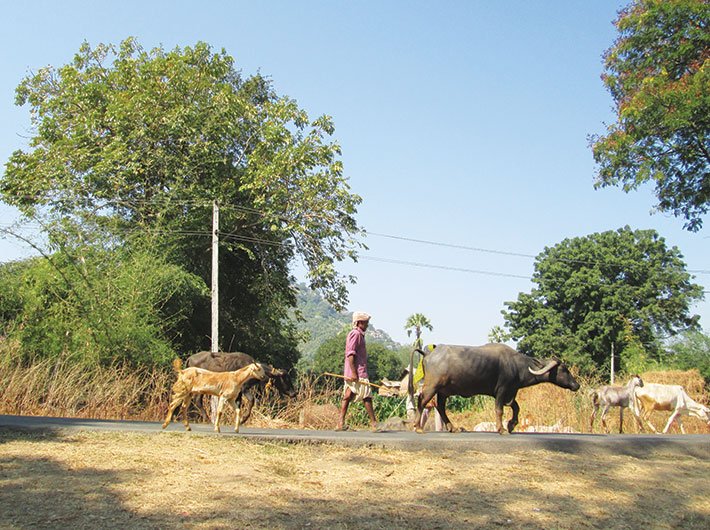It’s time to consider an alternative – a spatial approach which focuses on a geographical area for integrated development
The saying “India lives in its villages” is relevant even today, in the new millennium. There are as many 6,40,867 villages in India out of which 5,97,483 are ‘inhabited’ villages. Among them 82,149 villages have a population size of less than 200.
Most of the world economies, including India, possess a substantial rural sector. The 2011 Census estimates that 69 percent of the country’s population inhabits in villages. India’s economic development is projected on the basis of the development of its basic infrastructure in its 6,00,000-plus villages inhabited by the 700 million rural populations.
India is a democracy; hence its future depends upon the villages and it cannot hope to achieve and progress without removing the social and economic backwardness of the villages. Social and economic reconstruction of the country can be achieved only by a social and economic reconstruction of the villages.
In recent times there has been a move towards shifting the focus from rural development to village development. The programmes like Pradhan Mantri Adarsh Gram Yojana (PMAGY), Saansad Adarsh Gram Yojana (SAGY), Smart Village (Andhra Pradesh), Mana Uru Mana Pranalika (Telangana) are setting trends in this direction. And this trend needs to mainstreamed in our policies and programmes.
But how do we make a distinction between a rural area and a village? The census considers those areas as rural where the population is below 5,000 and the density of population is less than 400 per sq km. It further provides that in such areas at least 75 percent of the males of the working population are engaged in agricultural pursuits.
Generally speaking, a village is an aggregate of houses in a rural setting, smaller than a town and larger than a hamlet and without any urban body. In a village community an aggregate of people settle permanently in a definite geographical territory and develop a sense of community sentiment along with social, economic and cultural relations which mark them off from other communities.
If we understand the term ‘rural development’ literally, it only has a neutral meaning of ‘development’ in a geographically specific ‘rural’ area. Rural development is a non-linear and highly contextual process; so traditional and horizontal approaches fail to give answer to territory-specific questions. In Indian villages, readymade, preconceived, one-size-fits-all, “best” solutions designed somewhere else seldom work well.
There are two ways that development can be addressed – spatially or sectorally (aspatially). Most governments have traditionally favoured the aspatial or sectoral approach. This means that nationally, government departments and government policies are organised along sectoral lines, with different government departments responsible for different sectors of society – for example, a department of agriculture,
a department of enterprise, a department of transport, and so on.
The present model of rural development being implemented under overwhelming governmental domination (or the ones lacking community ‘ownership’) has not achieved expected results.
However, an alternative approach is gaining popularity – a spatial approach which focuses on a particular geographical area, and which seeks integrated development of it. Rural development by its nature is a more spatial concept which crosses sectoral bounds; therefore, it requires spatial rather than sectoral policy. This approach calls for a concentrated focus on village development by the village community.
Development, being endogenous and self-reliant, should stem from the heart of each society, and that it would acquire its full meaning only if rooted at the local level and in the praxis of each community. This, in turn, means that no development model can be universal and that the richness of development consists in the plurality of its patterns.
Although community development is not synonymous with the concept of rural development, community development is the major focus essential to the development of rural areas and therefore should be considered the central and major focus in rural development.
‘Ownership’ of project objectives is vital and the enabling environment should exist for local governmental institutions and community organisations to establish a collaborative partnership in undertaking the responsibility for developing a local ‘vision’ and strategy, and for designing/planning, allocating resources, implementing and monitoring/evaluating of development activities that better cater to local needs.
It is important that these different local players become the driving force towards development, develop a sense of shared ownership, and jointly manage their development initiatives. The ownership approach recognises that the rural community members themselves are the key agents of change for the transformation of rural areas. These agents of change, abundantly available in Indian villages, are eager to grab the opportunity to become active and meaningful partners in development of their villages which is now coming to them through our new approach of village development. It is for the policymakers to recognise this paradigm shift from rural to village development and mainstream it in our current development agenda and action.
Prasad is professor, National Institute of Rural Development & Panchayati Raj (NIRD&PR), Hyderabad.
(The column appears in the August 16-31, 2015 issue)
